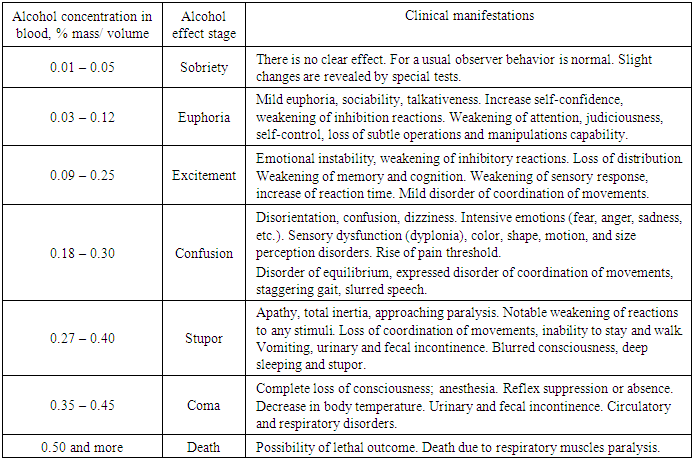-
Paper Information
- Paper Submission
-
Journal Information
- About This Journal
- Editorial Board
- Current Issue
- Archive
- Author Guidelines
- Contact Us
American Journal of Medicine and Medical Sciences
p-ISSN: 2165-901X e-ISSN: 2165-9036
2020; 10(7): 528-529
doi:10.5923/j.ajmms.20201007.18

Poisoning with Ethanol and Alcohol Surrogates
Khwan O. I., Iskandarov A. I., Nadjmitdinov S. B.
Tashkent Pediatric Medical Institute, Uzbekistan
Correspondence to: Nadjmitdinov S. B., Tashkent Pediatric Medical Institute, Uzbekistan.
| Email: |  |
Copyright © 2020 The Author(s). Published by Scientific & Academic Publishing.
This work is licensed under the Creative Commons Attribution International License (CC BY).
http://creativecommons.org/licenses/by/4.0/

Acute poisoning with ethyl alcohol and its surrogates is characterized by clinical signs of poisoning, dependent primarily on the concentration (dose) of consumed poison and its physical-chemical composition. Forensic diagnostics should be based on the results of clinical pattern and forensic chemical blood and urine tests of the victim.
Keywords: Forensic expertise, Acute and chronic alcohol intoxication, Thanatogenesis, Morphological alterations
Cite this paper: Khwan O. I., Iskandarov A. I., Nadjmitdinov S. B., Poisoning with Ethanol and Alcohol Surrogates, American Journal of Medicine and Medical Sciences, Vol. 10 No. 7, 2020, pp. 528-529. doi: 10.5923/j.ajmms.20201007.18.
Article Outline
- According to WHO, a quarter of all poisoning cases is taken by alcohol poisoning (WHO, 2016). More than 60% of all lethal poisoning cases are also included into that group. Basic reasons of lethal poisoning are considered to be consumption of a great amount of alcohol, especially fasting, chronic alcoholism, specific lifestyle, and family alcoholism [1,3]. Ethanol penetrates tissue membranes easily, fast absorbed in stomach (20%) and small intestine (80%). In average 1.5 hours its concentration in blood reaches a maximal level. Ethanol low doses act as a selective depressant on CNS, while its high doses act as general depressant; it has psychotropic (narcotic) effect, which is accompanied by suppression of excitement processes in CNS due to neuron metabolism, disorders in mediator system functioning, and inhibition of oxygen utilization [2].A significant role in the pathogenesis of poisoning is played by metabolic toxicosis and acidosis (accumulation of ethanol biotransformation products). Basic endogenous product is poisonous acetaldehyde formed in all variations of oxidative degradation of ethyl alcohol expressed intoxication develops when acetaldehyde dehydrogenase cannot convert acetaldehyde completely into acetate convert it to acetate. Acetaldehyde disrupts epinephrine and other catecholamines cerebral and peripheral cycle, it effects cardiovascular system, liver, and kidneys [4]. Main reasons of lethal outcomes of ethanol poisoning are acute cardiac failure, liver cirrhosis, renal failure, and total intoxication.The objective of the study was design of clinical and morphological assessment criteria for acute ethyl alcohol and its surrogates poisoning in hot climate.Materials for study were conclusions of forensic expertise of ethyl alcohol and its surrogates acute poisoning cases from 2010 to 2017, and results of our own autopsies (82 corpses) of people, who died due to alcohol poisoning and 76 cases of alcohol and its surrogates poisoning in alive people, treated at the Republican Scientific Emergency Medical Center (RSEMC). We performed the analysis od all clinical and laboratory research methods used in ethanol alcohol and its surrogates poisoning cases in RSEMC, and applied common morphological tests in lethal cases of this persons.Results of the study: Alcohol poisoning develops from stage to stage. Clinical progression depends on the dose. Acute poisoning should be suggested when health status of a person, who consumed a great dose of alcohol, suddenly deteriorates with development of consciousness impairments, loss of ability to walk, perception disorders, occurrence of stupor and coma. On the basis of the data of clinical pattern and taken from victims treated at RSEMC and results of forensic expertise we designed a table of acute ethanol poisoning in the conditions of our country.
|
 Abstract
Abstract Reference
Reference Full-Text PDF
Full-Text PDF Full-text HTML
Full-text HTML